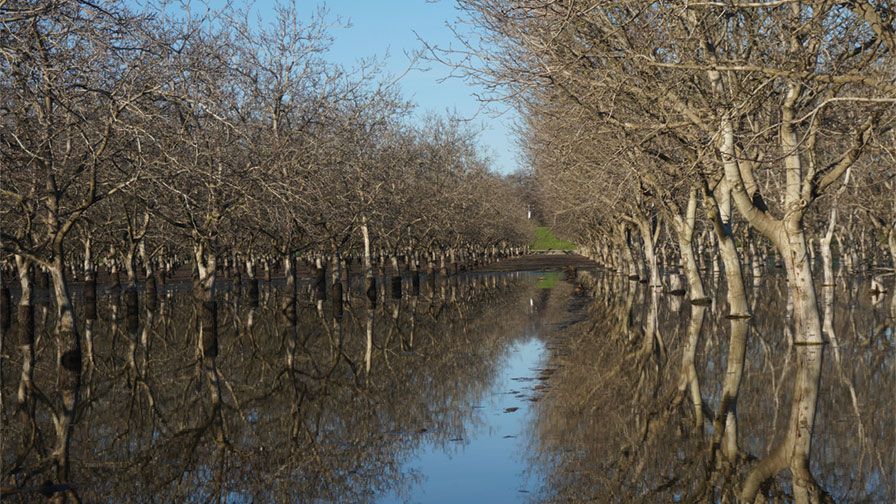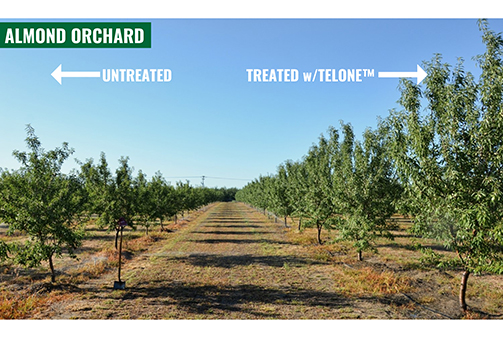Have Flooded Orchards? Keep an Eye out for Damage

Walnuts trees reflected in seepage water from the Feather River. (Photo: Janine Hasey)
From a series of tropical storms, California’s Yuba and Sutter Counties have experienced record-breaking rainfall events in January and February, which have resulted in very high river flows for many weeks. At this writing, orchards outside the levees along the rivers either are or have been flooded from river seepage due to high flows and/or overflowing ditches/canals.
With the record-breaking snow pack, there is uncertainty as to how long the rivers will have high flows and whether we will have to contend with additional flooding this spring and summer.
It likely will take months before the extent of losses from waterlogging and/or disease can be assessed.
By the summer months, we will have a better idea of orchard tree losses due to flood-induced root system damage. From recent research, substantial root growth in walnuts begins about a month after leaf-out and peaks in the summer. This should work in our favor for orchards that were flooded or saturated this spring. Also, tree damage from flooded soil is usually minimal if the flood occurs when the trees are dormant when respiration rates are lower in the roots or where the water continues to flow rather than remain standing in the orchard because of more dissolved oxygen in running water. Where water stands for extended periods in an orchard, two potential problems are of concern: 1) waterlogging of the root system, and 2) diseases caused by Phytophthora.

Swollen lenticels are seen on this waterlogged tree. (Photo: Janine Hasey)
Waterlogging
Waterlogging can be viewed as an “oxygen starvation” effect of flooding. When an orchard soil is flooded or otherwise saturated with water, the air in its pore spaces is displaced, removing the supply of oxygen to the roots. The terminal portions of new walnut roots can be killed within one to four days in a saturated soil. As saturation is prolonged, damage to roots becomes greater and can lead to chlorosis, leaf wilting, and in extreme cases, entire root systems can be killed.
As soil temperatures increase, the negative effects of waterlogging are accelerated. Walnut trees apparently survive waterlogging events during winter due to a combination of low-soil temperature and a lack of active roots. Waterlogging risk tends to be greater in “heavy” or compacted soils because of slower re-entry of oxygen after saturation. Following floods in previous years, we observed less injury to trees growing in deep, permeable soils than to trees growing on soils with impaired vertical drainage caused by a claypan or hardpan.
Waterlogging damage to walnut trees can vary in severity, may not manifest immediately, and can be difficult to discriminate from Phytophthora damage. For example, decline of walnut trees is sometimes not obvious until late spring or summer, when backhoe excavations can be used to confirm suspected waterlogging damage on walnut root systems.
Boundaries between dead, waterlogged portions of major roots and crowns and living parts of the same roots tend to be poorly defined and occur in the absence of distinct cankers and lab diagnostics that indicate Phytophthora crown and root rot. Waterlogged tissues often have swollen lenticels.
Phytophthora Diseases
Several species of the “water mold” Phytophthora are found in surface water sources such as our rivers and canals, as well as in infested soils. These fungal-like organisms can be carried along by the water and swim in it. After a levee break, the river water is a potential source of spreading Phytophthora inoculum throughout the flooded area. Flooding can bring active Phytophthora inoculum in contact with the aerial portions of trees, resulting in infections of the tree trunk, scaffolds, and shoots. Flooding also increases the risk of root and crown infections by Phytophthora. Some Phytophthora species preferentially infect roots, but many preferentially infect the root, crown, or aerial tree parts.
When Phytophthora infects woody tissues of trees above or below ground, it typically causes cankers (i.e., continuous, often-elliptical areas of dead bark, ranging from less than 1 inch to more than 1 foot across). The cankers often “bleed.” Removing the outer bark from the margin of a canker typically reveals a distinct, zonate (with concentric lines) margin, which is in contrast to the typically diffuse, non-zonate margin and vascular streaking evident at the edges of dead areas of waterlogged roots.
In general, cool to moderate temperatures and water-saturated conditions in or on soil favor tree infection by Phytophthora species. Some Phytophthora species are more virulent than others, and risk of disease also depends on genetic resistance of the rootstock or scion.
Within a given rootstock or scion, susceptibility to Phytophthora can vary with time of year. For example, in experiments on seasonal variation in susceptibility of walnut, almond, and peach rootstocks to Phytophthora citricola (which can cause root and crown rot and trunk and branch cankers), the rootstocks were least susceptible to infection during wintertime and most susceptible during the growing season.
In contrast, infection by Phytophthora syringae in almond and peach is most likely during the cool conditions of fall, winter, and early spring. These cankers cease development when summer temperatures become lethal to this “cool-temperature” pathogen.
Additional resources
For more information visit SacValleyOrchards.com/Blog/. The blog covers several flooding-related issues not mentioned here, including guidance on documenting and reporting damage and losses, and locating possible disaster relief resources for flooded orchards outside and inside the levees, including riverbank sloughing, such as what occurred extensively along the Feather River.
Management Guidelines to Consider with a Flooded Orchard
Follow these tips to help alleviate problems you might be experiencing with a flooded orchard.
- Drain or pump standing water out of orchards.
- Reduce vehicle/farm equipment traffic. Wet soils are easily compacted. Delay all operations that can wait until soil is dry enough to crumble at a depth of 5 to 6 inches rather than slick over or pack.
- Apply a phosphonate spray in May where Phytophthora is found or suspected. A summer and early fall application may also be needed.
- Ridomil (Syngenta) application is another option but is considered by some to be less cost effective than phosphonates for some Phytophthora diseases.
- Remove deposited silt and debris around the root crowns when possible to decrease the chances of root/crown decay. Use care not to nick or otherwise injure the root crown, which could provide an entrance for the crown gall organism.
- Encourage the growth of cover crops or even weeds that will help dry the soil after flooding; the plants are effective in drying waterlogged soils.
- Fill in eroded areas in orchards if soil is available. Deposited materials in many instances are beneficial.
- Check for salts (chloride and sodium); a continued high water table saturating surface soil may result in these salts accumulating or alkalization of certain spots which have shown these troubles before. Neither leaching nor gypsum treatments will be effective until the water table is lowered and good drainage can be achieved.
- For new orchards or replants where seepage is problematic, consider using clonal Paradox RX1 rootstock. It has high resistance to Phytophthora, but more observations are needed to determine how it performs under prolonged waterlogging.









